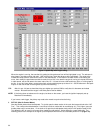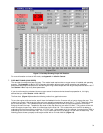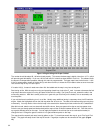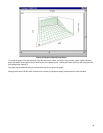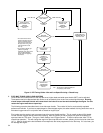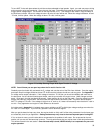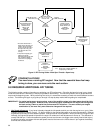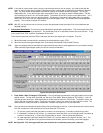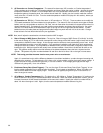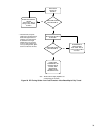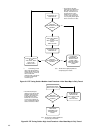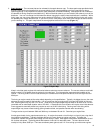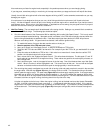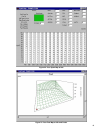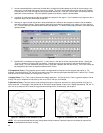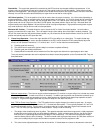38
B. AE Correction vs. Coolant Temperature – The second line down says “AE correction vs. Coolant temperature”.
These numbers are to modify the TPS based acceleration enrichment when the engine is colder. Just like the coolant
temperature modifiers, a number 110 for example adds 10% more acceleration enrichment fuel. When the engine
temperature gets up to operating level, the numbers should read 100. Usually you don’t need to make the numbers
much more than 110 when it is cold. Tune the coolant temperature modifiers first (step 6 in this section), before you
modify these values.
C. AE Correction vs. TPS (%) – The third line down is “AE correction vs. TPS (%)”. These numbers are to modify the
TPS based acceleration enrichment based on throttle position. The reason for this is that with some types of throttle
bodies, such as a single blade as used on a 5.0L Ford, more air flows when the throttle is first opened than when it is
already opened further. Consequently you need to add more acceleration enrichment fuel at this point. You might
raise the TPS values where the throttle starts to open to as high as 120 for single blade throttle bodies. Throttle
bodies that have 4 throttle plates and progressive throttle linkage may work well with 100 in all the cells. Change
these values to find out what works best for your application.
NOTE: Next, we will adjust the acceleration enrichment based on MAP changes.
A. Rate of Change of MAP Sensor (Fuel Units – The top line, “Rate of change of MAP Sensor (Fuel Units)” is similar
to the rate of change of TPS in that the left corresponds to slow change of the MAP sensor (engine load) and the right
corresponds to fast MAP sensor change. A slow change would be similar to slowly accelerating onto a road. A fast
change would be launching a car at the dragstrip. If you experience hesitation under load when lightly accelerating,
change the left three numbers. If you experience a hesitation when you floor the throttle, change the numbers more
towards the right. Multi-port systems will usually have numbers between 10 and 40 on the left and 30 to 60 on the
right. TBI systems usually require more fuel because of the distance between where the fuel is injected and the
cylinder. TBI systems may have numbers between 20 and 80 on the left to 40 to 100 on the right in some cases.
NOTE: This tuning provides the same function as a power valve on a carburetor.
Again, it is sometimes hard to tell the difference between rich and lean hesitations, so make changes increasing and
decreasing the numbers. To help determine if it is from a rich or lean problem, monitor the oxygen sensor voltage. If
it goes low (and the large rich/lean box goes red), it is a lean condition. If the voltage goes high (and the large
rich/lean box goes green), it is a rich condition.
B. Enrichment Decay Rate (Crank Triggers) – The next line down “Enrichment Decay Rate (Crank Triggers)” is how
fast the added acceleration fuel is removed after it is added. This is based on temperature. When it is colder, you
want to let the added fuel remain slightly longer. These values will typically range from up to 20 and down to 10
when the engine is warmer.
C. AE of Map vs. Coolant Temperature (%) – The bottom line, “AE of Map vs. Coolant Temperature (%)” performs the
same function as it did for the TPS based acceleration enrichment. When the coolant temperature is lower, you can
increase the amount of MAP based acceleration enrichment that is added. Usually the most this number will be is
about 110 when the engine is cold. Again, tune the coolant temperature modifier before tuning this.



